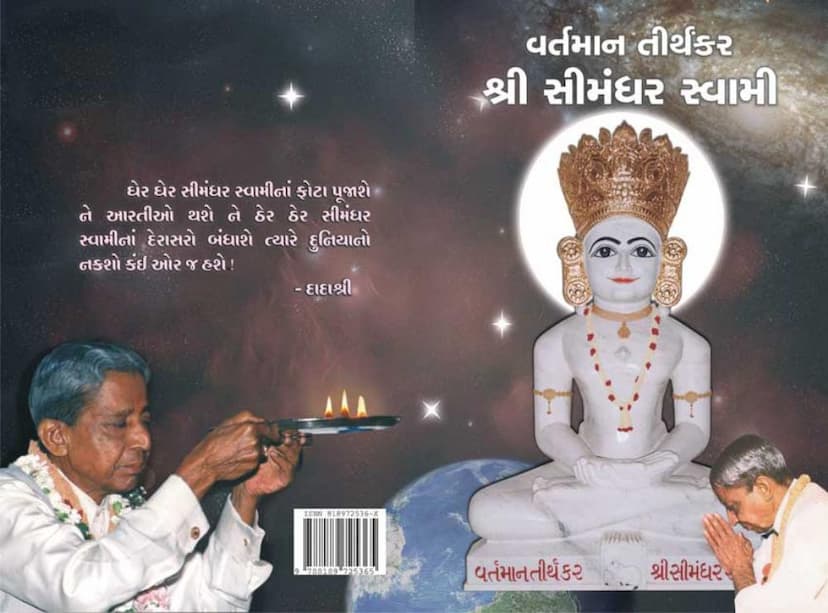Vartaman Tirthankar Shri Simandhar Swami
Added to library: September 2, 2025

Summary
Here's a comprehensive summary of the Jain text "Vartaman Tirthankar Shri Simandhar Swami" by Dada Bhagwan, based on the provided pages:
This book, published by Dada Bhagwan Foundation, focuses on Lord Simandhar Swami, who is presented as the current living Tirthankar of the Jain faith. The core message revolves around the significance of worshipping and connecting with Lord Simandhar Swami, especially in the current era (Pancham Kaal).
Key Themes and Concepts:
- The Current Living Tirthankar: The text emphasizes that while the 24 Tirthankaras of this era's Bharat Kshetra have attained liberation, Lord Simandhar Swami resides in Mahavideh Kshetra, a different continent within the same universe, and is actively present as a Tirthankar.
- The "Lift" Path to Moksha: Dada Bhagwan, the author and a Gnani Purush (Self-realized soul), presents an "Akram Marg" (instantaneous path) to moksha, contrasting it with the "Kram Marg" (gradual path) of climbing spiritual steps. He likens this to taking a lift versus climbing stairs, suggesting the Akram path is more accessible in this current age.
- Connection with Simandhar Swami: The book highlights that direct moksha from this geographical region (Bharat Kshetra) is not possible in this era. However, a path to moksha is available through connecting with Lord Simandhar Swami in Mahavideh Kshetra. Dada Bhagwan's teachings facilitate this connection, creating a strong "runanubandh" (karmic bond).
- The Importance of "Namo Arihantanam": A significant portion of the book delves into the correct understanding of the Navkar Mantra, specifically "Namo Arihantanam." Dada Bhagwan clarifies that "Arihant" refers to a living Tirthankar who has a physical body and is currently engaged in spiritual propagation. Since the 24 Tirthankaras of this era are now in the Siddha state (liberated), they are no longer "Arihants" but "Siddhas." Therefore, the mantra should be directed towards the presently living Tirthankaras like Simandhar Swami. Reciting it for those who have attained Siddhahood is considered an incomplete or misplaced devotion in this context.
- The Role of Dada Bhagwan: Dada Bhagwan is presented as a spiritual guide who facilitates the connection with Lord Simandhar Swami. He explains his own journey and realization, emphasizing that his role is to show the path to moksha, which is ultimately achieved through the grace of Lord Simandhar Swami. He directs his followers to worship Simandhar Swami, not himself.
- Mahavideh Kshetra: The text provides descriptions of Mahavideh Kshetra, its characteristics, and the presence of 20 Tirthankaras there, with Simandhar Swami being particularly relevant due to his connection with the Bharat Kshetra.
- Devotion and Worship: The book encourages devotion to Simandhar Swami through daily recitation of a specific mantra (40 times a day), meditation, and an unwavering sense of surrender. It stresses that sincere devotion, even with a statue or picture, is akin to worshipping a living Lord.
- Addressing Misconceptions: Dada Bhagwan clarifies common misunderstandings about Jain rituals, the Navkar mantra, and the nature of spiritual progress in the current era. He explains that the ultimate goal is self-realization and liberation, facilitated by the grace of the present Tirthankar.
- The Akram Path and its Benefits: The Akram Marg, as taught by Dada Bhagwan, leads to rapid spiritual progress and the possibility of achieving liberation within a few lifetimes, specifically by connecting with Simandhar Swami.
- Past and Present Tirthankaras: The book contrasts the worship of past Tirthankaras (who are now Siddhas) with the importance of worshipping the current Tirthankaras like Simandhar Swami. It emphasizes that the latter offers direct benefits for liberation in the present context.
- The "Dada Bhagwan" Identity: Dada Bhagwan clarifies that he is not a Tirthankar himself but a Gnani Purush who has realized the Akram path and guides others towards Lord Simandhar Swami. He emphasizes his role as a facilitator, not the ultimate goal.
- Building Temples for Simandhar Swami: The book mentions the construction of temples dedicated to Simandhar Swami as a way to propagate his worship and facilitate people's connection with him. This is seen as crucial for dispelling religious differences and fostering universal well-being.
- The "Vartaman Tirthankar" Concept: The central argument is that in the current age, the "Arihant" referred to in the Navkar mantra should be understood as the living Tirthankaras like Simandhar Swami, as the previous Tirthankaras have already attained Siddhahood.
In essence, "Vartaman Tirthankar Shri Simandhar Swami" serves as a guide to understanding and connecting with Lord Simandhar Swami as the key to spiritual liberation in the present era, as expounded by Dada Bhagwan's unique Akram Marg of Self-realization.